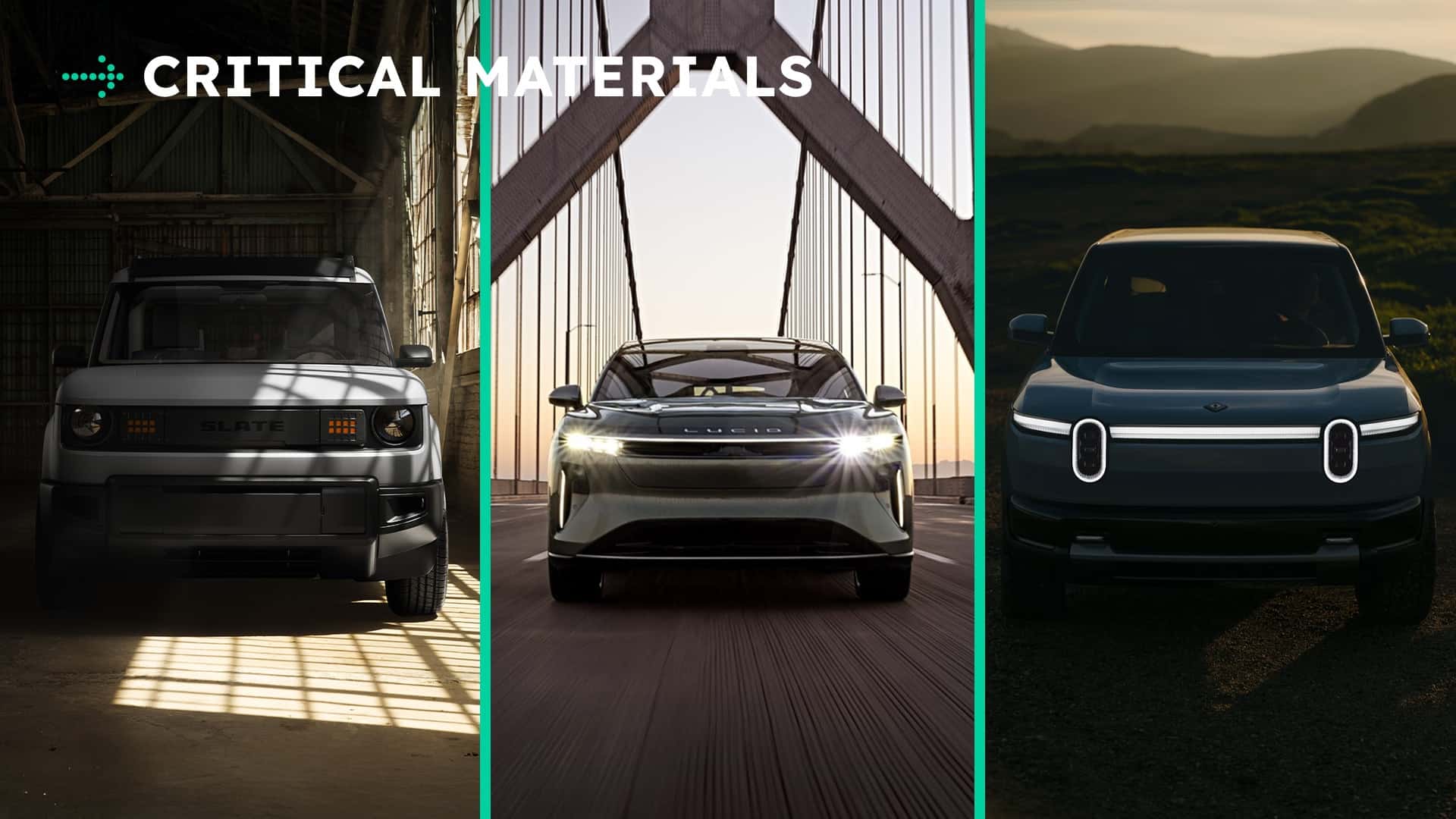
The last half-decade has been a roller coaster ride for the entire auto industry. Between the pandemic causing soul-crushing supply chain issues to the pent-up demand resulting in wildly inflated car prices, even the most hardened brands faced adversity.
Now, younger electric-vehicle makers are now facing a disproportionate hardship as the EV tax credit rides off into the sunset. That means just as they're learning to ride the metaphorical bicycle, big daddy government is coming to ratchet off its training wheels.
And that pavement below? It's not exactly pillow-soft. It's about to become very apparent which brands learn to ride on two wheels, and which ones end up with skinned knees.
Welcome back to Critical Materials, your daily roundup for all things electric and tech in the automotive space. Also on deck: Hyundai looks to Europe to save EV sales and neighbors of Tesla's Hollywood diner say that living next door is "absolute hell." Let's jump in.
30%: EV Startups Are About To Meet A Harder Market

Let's talk about newcomers like Rivian, Lucid and Slate Auto. Many of these brands were banking on the EV tax credit to help grow their brands, and now that it's going away in less than two months, these brands will have to compete with legacy automakers who can ride out the storm thanks to a mix of old money and carbon-burning combustion engines.
As you've undoubtedly heard, the $7,500 EV tax credit is going away at the end of September. With it goes an anticipated 320,000 would-be electric car buyers, effectively putting a big hole in the buoy that has kept these EV-only brands afloat in a cold ocean of hybrids.
Let's start with Slate, the Bezos-backed startup that originally promised an ultra-cheap, Saturn-like EV pickup for under $20,000. That price tag came with an asterisk, though, as it was dependent on the tax credit—the brand now hopes to reach the mid-$20,000s and knows it will need to eat some of the cost that it can't pass on to consumer.
The no-frills approach is actually pretty cool. Roll-up windows, no stereo. I mean, who does that in 2025?
And it's kind of the point—the novelty is willing over the internet, but as iSeeCars executive analyst Karl Brauer told Automotive News recently, that's a poor predictor of how well a vehicle will sell.
Most car buyers care about practicality and when prices start to climb into Ford Maverick territory, are buyers really not going to spend a few more dollars for the creature comforts offered by the Blue Oval?
Then come two heavier hitters: Rivian and Lucid. Both automakers are deep in the EV trenches, burning through billions of dollars in hopes that a new crossover (the R2 and Gravity, respectively) will help break them into more American households. But that $7,500 tax credit would've gone a long way to do so.
Now that the training wheels are coming off, Brauer says that the repeal of the EV tax credit could result in the EV market taking, at most, a 50% tumble from 8% down to somewhere between 4% and 5%.
Rivian expects a sales dip between 11% and 23% this year with only one quarter being affected by the loss of the EV tax credit (it sold 51,579 cars last year). Lucid, meanwhile, expects to more than double its production, though the majority of its vehicles don't qualify for the tax credit anyway
It also speaks to who will be buying them:
“They're only going to be left with the true believers,” said Brauer, specifically referring to consumers who will be unmoved by the repeal of the tax credit and still shop for EVs.
Granted, Rivian and Lucid aren't exactly new at this, they're both just fighting an uphill battle where batteries have been weaponized into becoming political landmines.
60%: Hyundai, Kia Tap Europe To Make Up For Lost U.S. EV Sales

America may be focused on imploding its EV growth efforts by pulling the plug for federal EV subsidies, but the rest of the world is chugging on ahead. Europe, for example, is quickly turning into the new focus for many automakers looking to ensure a return is made on their hefty investments into electric cars.
Hyundai and Kia are two brands that have dumped tons of money into new EVs, including moving production to the U.S. to ensure that they're eligible for the federal tax credit. But now that the $7,500 incentive will soon disappear, the brands have made it clear: Europe is now the main event.
Here's what the Korea Times has to say to justify the pivot to the European market:
The move reflects the firm’s strong commitment to expanding its presence in the European market. As Europe has strong demand for compact and practical eco-friendly cars, the carmaker sees the upcoming mobility fair as an ideal venue to debut the new model.
“Hit by the tariff imposition and reduced EV incentives from the U.S., Europe will become a major battlefield for global EV makers during the Trump presidency,” an auto industry official said.
“Hyundai Motor Group has a competitive edge in EVs over other global carmakers due to its broad vehicle lineup and price competitiveness, which raises hope for their deeper inroads into the market once they finish building the complete EV lineup.”
American buyers should see this as a wake-up call. Automakers, especially foreign ones, are exiting stop-and-wait mode. The U.S. has made its priorities clear, and those priorities no longer include incentivizing EVs—that includes both the production or purchasing of them. And when paired with tariffs, it's also abundantly clear that the priority also doesn't include affordable cars, especially when the majority of most automakers' low-cost vehicles are assembled outside of the U.S.
In Europe, that's a different story. In fact, EVs as a whole are treated a bit differently, with more robust and thought-out charging infrastructure and a set of policies that still give automakers a carrot-and-stick approach to low-emissions vehicles.
90%: Neighbors Say Living Next Door To Tesla's 24-Hour Diner Is 'Absolute Hell'

Tesla's diner of the (retro) future is here, complete with car-hop service, Superchargers and Optimus. It sounds pretty cool on paper, but in reality, it's a bit of a nightmare that has neighbors one honk away from spiraling into an existential crisis.
As it turns out, Tesla's four-story drive-in isn't leaving a great impression on the folks living just a few feet away from the big screens. Some are calling the entire ordeal (all the way back to initial construction) "unlivable," and have even moved out well ahead of the opening.
404 Media spoke to both former and current residents of the complex. It all started with construction back in 2023, according to one former resident who spoke up about their experience. They allege that crews worked on the site six days a week, from as early as 4 a.m. until as late as 9 p.m.—often outside of what was permitted by permitted construction hours. Meanwhile, the pollution from generators—both noise and emissions, according to the resident—slowly drove residents insane.
Here's a snippet from one complaint outlined by 404 Media:
First, there was the construction. “Last night they have installed a flashing security light up against our fence,” Kristin Rose, a former resident of the apartment building next to the Tesla Diner, said in an email to the building management and to Tesla in February 2024, during building works. “This light is flashing BRIGHT into our apartments, including bedrooms, all night. Even with the blinds closed it feels like we're at the world's worst rave.
Construction isn't forever. Eventually, the diner had to open, and that's when the real floodgates opened.
The screens went up and residents moved out. According to Rose, one couple who was in their apartment for at least 15 years couldn't deal with the change and, after having their apartment's view obstructed by one of the giant screens, left.
Cars also play a part in this. Residents complain about honking, people getting in and out of their cars, waiting in line, and general road congestion created by all of the interest generated by the site that requires people in high-visibility vests to direct traffic.
Residents haven't given up all hope. As 404 Media points out, some neighbors don't mind the hustle and bustle. But for those who have their balconies permanently obstructed by a giant screen with high-pitched fans, Tesla's flagship attraction has become a sore thumb more than anything.
Perhaps the most infuriating part is knowing that Tesla's much-hyped Hollywood diner could be the first of many in major cities across the world, according to Elon Musk, if it does well. That means more folks around the world could have one of these in their backyard before they know it.
100%: What's Slate's Next Move?

At $20,000, Slate's promise of a no-frills, tiny truck with roll-up windows is something I could be convinced of buying. It's not cheap, but considering that it's the priced of a 10-year-old Toyota Tacoma, just maybe I could be convinced to grab one as a runabout vehicle for errands and whatnot. For many people looking for an affordable second vehicle, a $375-per-month commitment isn't terrible.
But with the $7,500 tax credit going away and the price expected to be raised into to the mid-$20,000s, that payment could go up by around $100 per month.
Here's where I turn to you: How do you think that the tax credit going away will affect Slate? Has it changed your mind about purchasing one? Let me know in the comments.







